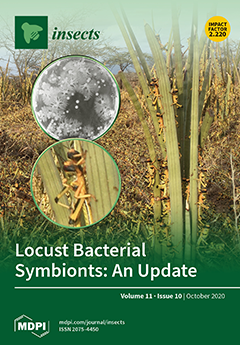Entomopathogenic fungi are naturally existing microbes, that can serve as a key regulator of insect pests in integrated pest management strategies. Besides having no hazardous effects on the environment, these entomopathogens are alternatives to synthetic insecticides that can control notorious insect-like
Plutella xylostella
[...] Read more.
Entomopathogenic fungi are naturally existing microbes, that can serve as a key regulator of insect pests in integrated pest management strategies. Besides having no hazardous effects on the environment, these entomopathogens are alternatives to synthetic insecticides that can control notorious insect-like
Plutella xylostella, a destructive pest of cruciferous crops. Three different species of entomopathogenic fungi were evaluated before the selection (high larval mortality and least LC
50) of
Metarhizum anisopliae. The study was designed to investigate the mortality, development, and immune responses of
P. xylostella when challenged with
M. anisopliae, a naturally existing soil-borne entomopathogenic fungus.
M. anisopliae resulted in high pest mortality by killing 93% of larvae. However, no statistically significant effect on hemocyte concentration was observed. The activity of enzymes (Phenoloxidase and Superoxide dismutase) and immune genes (Defensin, Spaetzle, Cecropin, Lysozyme, and Hemolin) did vary at different time points (24, 48, 72 and 96 h) after exposure to
M. anisopliae. Disturbance in the biological cycles of
P. xylostella was also detected, significantly shorter adult life span (8.11:6.87, M:F) and reduced fecundity (101 eggs/female) were observed along with disturbed larval and pupal duration. Results suggest that
M. anisopliae can efficiently hinder the
P. xylostella defense and developmental system, resulting in mortality and disturbed demography.
Full article






